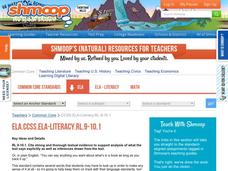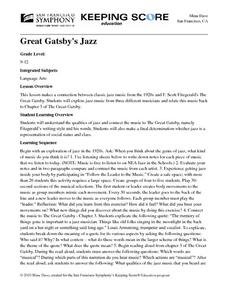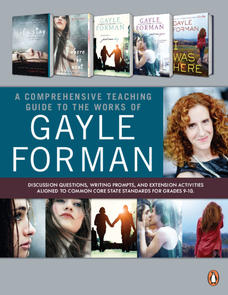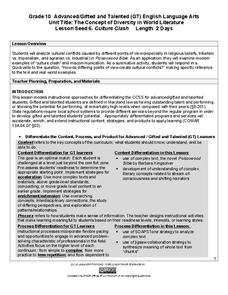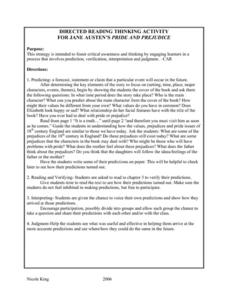Shmoop
ELA.CCSS.ELA-Literacy.RL.9-10.1
Does your ELA class need some practice with the specific skills outlined in the Common Core standards? Then this is the perfect resource for you! One in a series of connected lessons that cover the standards for reading literature,...
Curated OER
Great Gatsby's Jazz
As Nick wanders the grounds of Gatsby's mansion, he observes the behaviors of the rowdy guests and listens to the music pouring over the lawn. Bring the music of the jazz age into the classroom with Louis Armstrong's "West End Blues,"...
English Linx
Textual Evidence Worksheet
Perfect for a unit on characterization and simple enough to use with any text. Your class will practice the Common Core standard of citing textual evidence to support their analysis by first making an assertion about a character from a...
Curated OER
From Light to Dark and Back
Experiment with light and dark in a series of interactive activities that lead up to reading and writing poetry. Class members have the opportunity to observe their feelings while sitting in the light and dark and to play with shadow...
Pulitzer Center
"Voices from Haiti": Using Poetry to Speak up for a Cause
Explore a real world use of poetry with your class! Young language arts pupils consider the concept of advocacy and how journalism, photography, and poetry can raise awareness for a cause. They read several poems about individuals...
Curated OER
Dracula: Directed Reading Thinking Activity (DRTA)
“There are often dangers from snow and wolves and night.” Bram Stoker’s “Dracula’s Guest,” which may or may not have been the first chapter of the original Dracula manuscript, is the focus of a Directed Reading Thinking Activity (DRTA).
Curated OER
Setting Details in Of Mice and Men
After completing John Steinbeck’s Of Mice and Men, groups are assigned a chapter to reread. Members list major conflicts and events and quote setting details. They then make observations about how the setting prepares the reader for the...
Curated OER
Agriculture Awareness Through Poetry
Whether you are viewing a landscape painting of a farm, examining a still-life portrait of a bowl of fruit, or reading a descriptive poem about cultivating food, you can't deny that agriculture plays a major role in visual and language...
Curated OER
Flying Freudian Fun: A Look At Ethical Decision Making
There are not many more apt examples of ethics gone awry than William Golding's Lord of the Flies.. Ninth graders focus the ethics of decision making with the examples provided in the plot. They focus on the concept of the psyche and how...
Penguin Books
An Educator’s Guide to Gayle Forman
Sometimes a novel is the best way to tackle a tough topic. A helpful educator's guide for the novels of Gayle Forman discuss tough topics such as teenage suicide. Discussion questions and writing activities encourage readers to think...
National Park Service
Petrified Forest National Park
Poetry Soup, a reading and writing unit constructed by the Petrified Forest National Park, will have scholars hungry to learn about nature. The cross-content unit contains topics related to history, science, and language arts. Content...
Maryland Department of Education
The Concept of Diversity in World Literature Lesson 6: Culture Clash
To prepare for a Quickwrite on the question, "How do different points of view create cultural conflicts?" class groups draw examples of religious, cultural, and political conflicts from Things Fall Apart and The Poisonwood Bible to use...
Manchester University
Alliteration
Kids create cool clauses selecting a single starting sound. Ah, alliteration.
Novelinks
Count of Monte Cristo: Concept/Vocabulary Analysis
Explore the complex themes of Alexandre Dumas' The Count of Monte Cristo with a concept and vocabulary analysis lesson plan. Lead your class in a discussion about the underlying social and historical issues surrounding the novel, as well...
Curated OER
The Pearl: Directed Reading Thinking Activity
Guide readers to think about what they are reading with a comprehension activity. Using John Steinbeck's The Pearl, learners predict what is coming, verify and judge their predictions, and analyze what they are reading more closely.
Curated OER
Shizuko’s Daughter: Discussion Web
Is Yuki a selfish character? Analyze her motivation and behavior during a unit on Shizuko's Daughter by Kyoko Mori. Readers fill out two sides of a graphic organizer with reasons why or why not she is selfish, and then come up with a...
Curated OER
Shizuko’s Daughter: Selective Reading Guide
Examine the text of Kyoko Mori's Shizuko's Daughter with a reading guide. With questions that prompt kids to refer to the reading as well as to their own experiences and opinions, the guide is an effective way to keep them engaged with...
Curated OER
Shizuko’s Daughter: Question Answer Relationships
Asking questions about what you're reading is an effective way to connect with the text. After kids read passages from Kyoko Mori's Shizuko's Daughter, they identify questions about the passages as Right There, Think and Search, On Your...
Novelinks
The Crucible: Questioning Strategies Bloom's Taxonomy
Enrich your unit on Arthur Miller's The Crucible with a list of reading questions based on Bloom's Taxonomy. Kids answer questions and provide context for the knowledge, comprehension, application, analysis, synthesis, and evaluation...
Curated OER
Pride and Prejudice: Directed Reading Thinking Activity
Can you judge a book by its cover? Decide who and what Jane Austen's Pride and Prejudice is about with a prediction activity. Before reading the first three chapters of the book, kids answer questions based on their interpretation of the...
Curated OER
Pride and Prejudice: Concept/Vocabulary Analysis
Clarify the setting, literary themes, and potential vocabulary issues with a concept analysis resource. With thoughtful explanations of many parts of Jane Austen's Pride and Prejudice, the reference sheet will be a great addition to your...
Polk Bros Foundation
I Can Locate and Classify Information About a Topic
After reading a text, ask your pupils to recall and organize what they've just learned into a blank three-column chart. Class members write the topic and fill in the columns with information. The sheet also prompts students to write a...
Polk Bros Foundation
I Can Analyze a Story or History Completely and Carefully
Start off analysis of a text with a worksheet that asks pupils to complete several tasks. Class members note down a couple of characters or people and their distinguishing traits, describe the most important event, summarize the text...
Polk Bros Foundation
I Can Analyze Cause and Effect
Examine cause and effect by asking pupils to fill out a basic graphic organizer. The template is for any story or event and provides a line for writing in the story or event title. Pupils write in two causes in the circles and the change...


